To explore modern flute music genres, start with contemporary classical styles that utilize extended techniques like multiphonics and flutter-tonguing. Next, immerse yourself in jazz, focusing on personal expression and rhythmic flexibility. Don't forget to embrace diverse world music influences, enriching your sound with global rhythms. Experiment with electronic elements like effects pedals and loop stations to create innovative soundscapes. Finally, discover New Age trends that emphasize tranquility and emotional resonance, appealing to listeners seeking mindfulness. Each genre offers unique opportunities for artistry, and you'll uncover even more exciting insights as you engage further with these modern concepts.
Key Takeaways
- Explore extended techniques like multiphonics and circular breathing to create diverse sound textures and enhance your contemporary flute performances.
- Embrace improvisation to develop your unique style, particularly in jazz and world music settings, encouraging creative expression.
- Incorporate electronic elements, such as effects pedals and loop stations, to expand your soundscapes and engage audiences in innovative ways.
- Collaborate with musicians from various genres to deepen your understanding and foster community, enhancing your overall musical experience.
- Focus on creating serene and immersive soundscapes in New Age music, promoting relaxation and emotional resonance with your audience.
Explore Contemporary Classical Flute

Exploring contemporary classical flute music opens up a world of innovative sounds and techniques that challenge traditional boundaries. As a flutist, you'll encounter extended techniques that expand your expressive palette. These techniques, such as multiphonics, flutter-tonguing, and harmonics, enable you to create textures and colors that push the limits of what the flute can do.
You'll find that incorporating these methods not only enriches your playing but also invites listeners into a more visceral experience.
Flute improvisation is another exciting element of contemporary classical music. Unlike the rigid structures often found in traditional compositions, improvisation allows you to tap into your creativity, giving you the freedom to explore musical ideas spontaneously. This practice can deepen your connection to the music and enhance your personal style.
By embracing improvisation, you'll cultivate a sense of belonging within the contemporary music community, fostering collaboration and interaction with fellow musicians.
As you explore further into this genre, pay attention to the works of modern composers who are redefining flute music. Engage with pieces that utilize extended techniques and challenge your notions of melody and rhythm.
You'll discover that mastering advanced flute techniques is essential for fully realizing the potential of your instrument in this evolving genre.
You'll discover that contemporary classical flute music isn't just about the notes; it's about the emotional journey you and your audience embark upon together.
Dive Into Jazz Flute Styles

Contemporary classical techniques lay a solid foundation for exploring the vibrant world of jazz flute styles.
As you engage, you'll discover that jazz isn't just about notes but also about expression and creativity. By mastering jazz improvisation techniques, you'll open new avenues for personal expression that can elevate your playing to new heights.
Here are three essential elements to reflect on as you immerse yourself in jazz flute styles:
- Rhythmic Flexibility: Jazz often requires you to break free from strict timing. Practice playing with syncopation and swing rhythms to give your flute lines a lively, engaging feel.
- Melodic Variation: Don't be afraid to modify melodies. Experimenting with ornamentation and phrasing can add a unique twist to familiar tunes, allowing your personality to shine through.
- Flute Ensemble Collaborations: Embrace the opportunity to play with other musicians. Jazz is a collective art form, and engaging in flute ensemble collaborations can enhance your improvisational skills while fostering a sense of community. Joining an ensemble provides a transformative journey that enriches personal growth and musical exploration.
Embrace World Music Influences

Incorporating world music influences into your flute playing can dramatically expand your musical palette. As you explore various global rhythms, you'll discover a richness that adds depth to your sound. The flute has a unique ability to adapt, allowing you to blend styles from different cultures seamlessly.
Whether it's the intricate patterns of Indian classical music or the vibrant melodies of African folk tunes, embracing these influences can create an enchanting cultural fusion in your performances.
Start by investigating different genres. Listen to traditional music from diverse regions—think Middle Eastern, Latin American, and Asian sounds. Notice how the flute interacts with other instruments, and pay attention to the rhythmic structures. You might find yourself inspired to experiment with new techniques, such as breath control or articulation, that are common in these styles. Additionally, consider the distinctive timbre of various flutes to enhance your exploration of different genres.
As you practice, try incorporating specific global rhythms into your pieces. This not only enhances your technical skills but also brings an authentic feel to your music. You might even consider collaborating with musicians from different backgrounds to deepen your understanding of their traditions and styles.
Experiment With Electronic Flute Sounds

The world of electronic music offers an exciting playground for flute players enthusiastic to push the boundaries of their sound. By experimenting with electronic flute sounds, you can create unique pieces that blend traditional techniques with innovative approaches. This exploration allows you to craft rich digital soundscapes and synthesized textures that captivate your audience.
Here are three ways to engage in electronic flute experimentation:
- Use Effects Pedals: Incorporating effects pedals can transform your flute's natural sound. Reverb, delay, and distortion can add depth and layers, enhancing your performance and creating an immersive experience.
- Experiment with Loop Stations: Loop stations allow you to build complex compositions in real-time. Layering your flute melodies with harmonies and rhythmic patterns can result in mesmerizing soundscapes that evolve dynamically throughout your performance.
- Incorporate Software and Apps: Explore digital audio workstations (DAWs) and apps designed for sound manipulation. These tools can help you manipulate your flute recordings, adding synthesized textures and effects that redefine your music's character.
As you venture into the domain of electronic sounds, remember that this journey isn't just about technology—it's about expressing your creativity. Embrace the fusion of the flute with electronic elements, and you'll find a welcoming community of fellow musicians enthusiastic to share in this transformative experience. Additionally, utilizing tools like tuners and metronomes can enhance your precision in these experimental sessions.
Your unique sound could inspire others to explore this exciting intersection of genres.
Discover New Age Flute Trends

Amidst the tranquil soundscapes of New Age music, flute trends are evolving, inviting musicians to explore new domains of expression. You'll find that today's flutists are blending traditional techniques with contemporary elements, crafting a unique auditory experience that resonates deeply with listeners seeking peace and connection.
Ethereal soundscapes dominate the genre, often characterized by spacious arrangements and soothing melodies. By incorporating extended techniques such as circular breathing and harmonics, you can create a mesmerizing atmosphere that captures the essence of the New Age movement. This approach not only enhances your performances but also encourages a sense of belonging within the community of like-minded artists and enthusiasts.
Additionally, the integration of ambient backgrounds and nature sounds can elevate your flute compositions. Layering your flute melodies over gentle synth pads or recording natural soundscapes fosters an immersive experience that promotes relaxation and introspection. This is particularly appealing to those looking for healing vibrations in their music. Traditional flute melodies evoke emotional resonance, connecting deeply with the listener's experiences.
As you navigate these trends, consider collaborating with other musicians or exploring digital platforms to share your work. Engaging with a wider audience can open doors to new opportunities and enrich your creative journey.
Embracing these New Age flute trends won't only enhance your musical identity but also connect you with a community that values authenticity, healing, and shared experiences. So, immerse yourself in these trends, and let your flute become a vessel for serenity and connection.
Frequently Asked Questions
What Are the Best Resources for Learning Modern Flute Techniques?
If you're looking to enhance your modern flute techniques, consider exploring online courses that offer interactive learning and expert guidance.
Websites like Coursera and Udemy provide structured lessons tailored to various skill levels.
Additionally, investing in technique books by renowned flutists can deepen your understanding and provide practical exercises.
Combining these resources won't only improve your skills but also connect you with a community of passionate flutists enthusiastic to share their experiences.
How Do I Choose a Flute Suitable for Contemporary Styles?
Choosing a flute suitable for contemporary styles involves considering materials and sound projection.
Look for flutes made from silver or gold, as these materials enhance tonal quality and warmth. They also improve sound projection, essential for modern performances.
Test different headjoints, as they can notably influence how your flute responds.
Ultimately, select a flute that resonates with your personal style and offers the versatility needed for diverse contemporary music.
Your choice should inspire confidence and creativity.
Can I Incorporate My Classical Training Into Modern Genres?
Absolutely, you can blend your classical training with modern genres.
Imagine a flutist who takes Bach's intricate melodies and infuses them into a jazz improvisation. This classical fusion creates a rich tapestry of sounds that resonates with diverse audiences.
By genre blending, you can explore new rhythms and styles while showcasing your technical skills.
Embrace your background, and let it inspire your creativity, making your music both personal and relatable to others.
What Are Some Recommended Flute Brands for Electronic Music?
When exploring flute brands for electronic music, consider those that embrace flute technology advancements.
Brands like Yamaha and Azumi offer instruments designed for electronic sound manipulation, allowing you to experiment with effects and tones.
Look for models equipped with modern features, enhancing your creativity.
These flutes not only cater to the traditional sound but also adapt well to contemporary styles, making them perfect for blending genres and connecting with like-minded musicians.
How Can I Collaborate With Other Musicians in These Genres?
To enhance your collaboration with other musicians, consider various collaboration strategies that promote genre fusion.
Start by reaching out to local or online artists who share your interests. Attend workshops, jam sessions, or open mic nights to connect organically.
Utilize social media platforms to showcase your work and invite others to collaborate.
Don't hesitate to experiment with different styles, as blending genres can lead to exciting and innovative projects that resonate with diverse audiences.
Conclusion
In today's diverse musical landscape, blending traditional techniques with innovative styles can transform your flute playing. While contemporary classical pieces demand precision and emotion, jazz invites improvisation and spontaneity. World music influences expand your cultural horizons, while electronic sounds challenge the boundaries of the instrument. Finally, New Age trends offer a serene escape amidst a frenetic world. By embracing these genres, you not only enhance your skills but also enrich your artistic identity, creating a unique voice in modern music.






